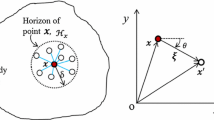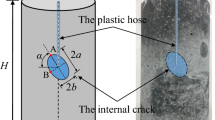Abstract
A new model for upward transport of buoyant fluid released during metamorphism is proposed. The model is fluid transport by buoyancy-driven propagation of isolated fluid-filled cracks. The mechanical behavior of a two-dimensional, isolated, vertical, and fluid-filled crack in impermeable rock is investigated using linear fractire mechanics and fluid dynamics. The results show that steady-state crack propagation which causes long-distance transport of the fluid occurs when the vertical cross-sectional area of the crack exceeds a critical value. Propagation velocity and average thickness of the crack under the steady-state propagation regime are expressed explicitly by the following seven parameters: vertical crack length; rigidity, Poisson's ratio, and fracture toughness of the rock; fluid viscosity; density difference between the rock and the fluid; gravitational acceleration. An isolated H2O-filled crack of vertical length 100 m, for example, propagates upwards in the crust at ∼0.3 m/s with the average thickness ∼0.2 mm when the following likely values are assumed: 0.1 mPa s for the H2O viscosity; 3 MPa m1/2 for the fracture toughness of the crustal rock. The application of the obtained results to the transport of H2O released during metamorphism suggests that the number density of isolated cracks propagating in the crust is very low. Since the propagation velocity is high, our model is suitable particularly for fluid transport through hot quartz-rich rock where fluid-filled cracks have geologically short lifetimes.
Similar content being viewed by others
References
Atkinson BK, Meredith PG (1987) Experimental fracture mechanics data for rocks and minerals. In: Atkinson BK (ed) Fracture mechanics of rock. Academic Press, London, pp 477–525
Bailey RC (1990) Trapping of aqueous fluids in the deep crust. Geophys Res Lett 17:1129–1132
Bickle MJ, McKenzie D (1987) The transport of heat and matter by fluids during metamorphism. Contrib Mineral Petrol 95:384–392
Connolly JAD, Thompson AB (1989) Fluid and enthalpy production during regional metamorphism. Contrib Mineral Petrol 102:347–366
Cox SF, Etheridge MA (1983) Crack-seal fibre growth mechanisms and their significance in the development of oriented layer silicate microstructures. Tectonophysics 92:147–170
Dziewonski AM, Anderson DL (1981) Preliminary reference Earth model. Phys Earth Planet Inter 25:297–356
Finger LW, Ko J, Hazen RM, Gasparik T, Hemley RJ, Prewitt CT, Weidner DJ (1989) Crystal chemistry of phase B and an anhydrous analogue: implications for water storage in the upper mantle. Nature 341:140–142
Fyfe WS, Price NJ, Thompson AB (1978) Fluids in the Earth's crust. Elsevier, Amsterdam
Ishida M (1987) Stress intensity factor of a crack under polynomial distribution of stress in an infinite plate. In: Murakami Y (ed) Stress intensity factors handbook, vol 1. Pergamon Press, Oxford, p 189
Lister JR (1990) Buoyancy-driven fluid fracture: the effects of material toughness and of low-viscosity precursors. J Fluid Mech 210:263–280
Maaløe S (1987) The generation and shape of feeder dykes from mantle sources. Contrib Mineral Petrol 96:47–55
Nishioka M, Iida S, Ichikawa Y (1975) An experimental investigation of the stability of plane Poiseuille flow. J Fluid Mech 72:731–751
Nishiyama T (1989) Kinetics of hydrofracturing and metamorphic veining. Geology 17:1068–1071
Peacock SM (1990) Numerical simulation of metamorphic pressuretemperature-time paths and fluid production in subducting slabs. Tectonics 9:1197–1211
Pollard DD (1976) On the form and stability of open hydraulic fractures in the Earth's crust. Geophys Res Lett 3:513–516
Ramsay JG (1980) The crack-seal mechanism of rock deformation. Nature 284:135–139
Roedder E (1984) Changes in inclusions after trapping. In: Ribbe PH (ed) Fluid inclusions (Reviews in Mineralogy 12). Mineral Soc Am, Washington, DC, pp 47–77
Secor DT, Pollard DD (1975) On the stability of open hydraulic fractures in the Earth's crust. Geophys Res Lett 2:510–513
Smith DL, Evans B (1984) Diffusional crack healing in quartz. J Geophys Res 89:4125–4135
Stevenson DJ (1981) Models of the Earth's core. Science 214:611–619
Stolper E, Walker D, Hager BH, Hays JF (1981) Melt segregation from partially molten source regions: the importance of melt density and source region size. J Geophys Res 86:6261–6271
Takada A (1990) Experimental study on propagation of liquid-filled crack in gelatin: shape and velocity in hydrostatic stress condition. J Geophys Res 95:8471–8481
Tatsumi Y, Hamilton DL, Nesbitt RW (1986) Chemical characteristics of fluid phase released from a subducted lithosphere and origin of arc magmas: evidence from high-pressure experiments and natural rocks. J Volcanol Geothermal Res 29:293–309
Walther JV, Orville PM (1982) Volatile production and transport in regional metamorphism. Contrib Mineral Petrol 79:252–257
Walther JV, Wood BJ (1984) Rate and mechanism in prograde metamorphism. Contrib Mineral Petrol 88:246–259
Weertman J (1971a) Theory of water-filled crevasses in glaciers applied to vertical magma transport beneath oceanic ridges. J Geophys Res 76:1171–1183
Weertman J (1971b) Velocity at which liquid-filled cracks move in the Earth's crust or in glaciers. J Geophys Res 76:8544–8553
Yardley BWD (1986) Fluid migration and veining in the Connemara Schists, Ireland. In: Walther JV, Wood BJ (eds) Fluid-rock interactions during metamorphism. Springer, Berlin Heidelberg New York, pp 109–131
Author information
Authors and Affiliations
Rights and permissions
About this article
Cite this article
Nakashima, Y. Buoyancy-driven propagation of an isolated fluid-filled crack in rock: implication for fluid transport in metamorphism. Contr. Mineral. and Petrol. 114, 289–295 (1993). https://doi.org/10.1007/BF01046532
Received:
Accepted:
Issue Date:
DOI: https://doi.org/10.1007/BF01046532




